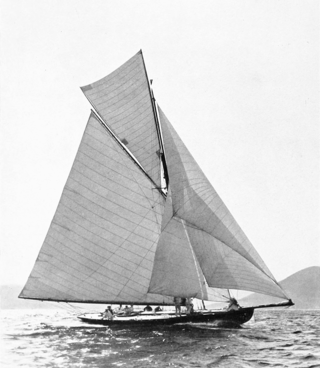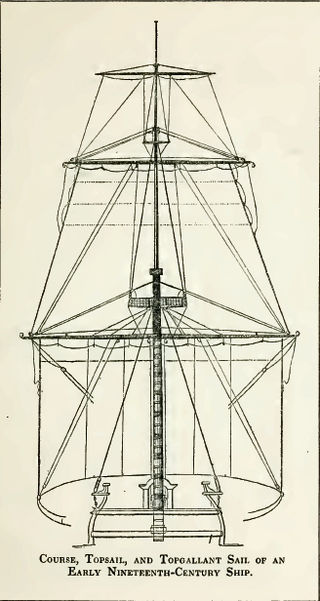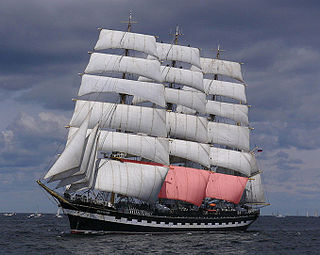
A sloop is a sailboat with a single mast typically having only one headsail in front of the mast and one mainsail aft of (behind) the mast. Such an arrangement is called a fore-and-aft rig, and can be rigged as a Bermuda rig with triangular sails fore and aft, or as a gaff-rig with triangular foresail(s) and a gaff rigged mainsail.

A sailboat or sailing boat is a boat propelled partly or entirely by sails and is smaller than a sailing ship. Distinctions in what constitutes a sailing boat and ship vary by region and maritime culture.

A sailing vessel's rig is its arrangement of masts, sails and rigging. Examples include a schooner rig, cutter rig, junk rig, etc. A rig may be broadly categorized as "fore-and-aft", "square", or a combination of both. Within the fore-and-aft category there is a variety of triangular and quadrilateral sail shapes. Spars or battens may be used to help shape a given kind of sail. Each rig may be described with a sail plan—formally, a drawing of a vessel, viewed from the side.
A jib is a triangular sail that sets ahead of the foremast of a sailing vessel. Its forward corner (tack) is fixed to the bowsprit, to the bows, or to the deck between the bowsprit and the foremost mast. Jibs and spinnakers are the two main types of headsails on a modern boat.

A jibe (US) or gybe (Britain) is a sailing maneuver whereby a sailing vessel reaching downwind turns its stern through the wind, which then exerts its force from the opposite side of the vessel. Because the mainsail boom can swing across the cockpit quickly, jibes are potentially dangerous to person and rigging compared to tacking. Therefore, accidental jibes are to be avoided while the proper technique must be applied so as to control the maneuver. For square-rigged ships, this maneuver is called wearing ship.

A topsail ("tops'l") is a sail set above another sail; on square-rigged vessels further sails may be set above topsails.

A backstay is a piece of standing rigging on a sailing vessel that runs from the mast to either its transom or rear quarter, counteracting the forestay and jib. It is an important sail trim control and has a direct effect on the shape of the mainsail and the headsail. Backstays are generally adjusted by block and tackle, hydraulic adjusters, or lines leading to winches.

A spinnaker is a sail designed specifically for sailing off the wind on courses between a reach to downwind. Spinnakers are constructed of lightweight fabric, usually nylon, and are often brightly colored. They may be designed to perform best as either a reaching or a running spinnaker, by the shaping of the panels and seams. They are attached at only three points and said to be flown.

A mainsail is a sail rigged on the main mast of a sailing vessel.

A cutter is a name for various types of watercraft. It can apply to the rig of a sailing vessel, to a governmental enforcement agency vessel, to a type of ship's boat which can be used under sail or oars, or, historically, to a type of fast-sailing vessel introduced in the 18th century, some of which were used as small warships.

Gaff rig is a sailing rig in which the sail is four-cornered, fore-and-aft rigged, controlled at its peak and, usually, its entire head by a spar (pole) called the gaff. Because of the size and shape of the sail, a gaff rig will have running backstays rather than permanent backstays.

Running rigging is the rigging of a sailing vessel that is used for raising, lowering, shaping and controlling the sails on a sailing vessel—as opposed to the standing rigging, which supports the mast and bowsprit. Running rigging varies between vessels that are rigged fore and aft and those that are square-rigged.

A Bermuda rig, Bermudian rig, or Marconi rig is a configuration of mast and rigging for a type of sailboat and is the typical configuration for most modern sailboats. This configuration was developed in Bermuda in the 17th century; the term Marconi, a reference to the inventor of the radio, Guglielmo Marconi, became associated with this configuration in the early 20th century, because the wires that stabilize the mast of a Bermuda rig reminded observers of the wires on early radio masts.

Sail components include the features that define a sail's shape and function, plus its constituent parts from which it is manufactured. A sail may be classified in a variety of ways, including by its orientation to the vessel and its shape,. Sails are typically constructed out of flexible material that is shaped by various means, while in use, to offer an appropriate airfoil, according to the strength and apparent direction of the wind. A variety of features and fittings allow the sail to be attached to lines and spars.

In sailing, a boom is a spar (pole), along the of a fore and aft rigged sail, that greatly improves control of the angle and shape of the sail. The primary action of the boom is to keep the foot flatter when the sail angle is away from the centerline of the boat. The boom also serves as an attachment point for more sophisticated control lines. Because of the improved sail control it is rare to find a non-headsail without a boom, but lateen sails, for instance, are loose-footed. In some modern applications, the sail is rolled up into the boom for storage or reefing.

A fractional rig on a sailing vessel consists of a foresail, such as a jib or genoa sail, that does not reach all the way to the top of the mast.
A mast-aft rig is a sailboat sail-plan that uses a single mast set in the aft half of the hull. The mast supports fore-sails that may consist of a single jib, multiple staysails, or a crab claw sail. The mainsail is either small or completely absent. Mast-aft rigs are uncommon, but are found on a few custom, and production sailboats.

A sail is a tensile structure, which is made from fabric or other membrane materials, that uses wind power to propel sailing craft, including sailing ships, sailboats, windsurfers, ice boats, and even sail-powered land vehicles. Sails may be made from a combination of woven materials—including canvas or polyester cloth, laminated membranes or bonded filaments, usually in a three- or four-sided shape.
A solent refers to a sail and rigging system on sailboats, typically sloops. Sailors, particularly British sailors, often refer to a 100% jib as a Solent, because its smaller size is preferable when sailing in the strong winds found in the Solent between the Isle of Wight and Britain. The common use of roller-furling headsails, or genoas, on modern cruising yachts allows the jib to be reduced in size, but partially-furled sails lack the efficiency of a sail that is actually cut to a smaller size. Accordingly, it is preferable to fly a separate, smaller jib—the solent—instead.

A sail plan is a drawing of a sailing craft, viewed from the side, depicting its sails, the spars that carry them and some of the rigging that supports the rig. By extension, "sail plan" describes the arrangement of sails on a craft. A sailing craft may be waterborne, an iceboat, or a sail-powered land vehicle.

















